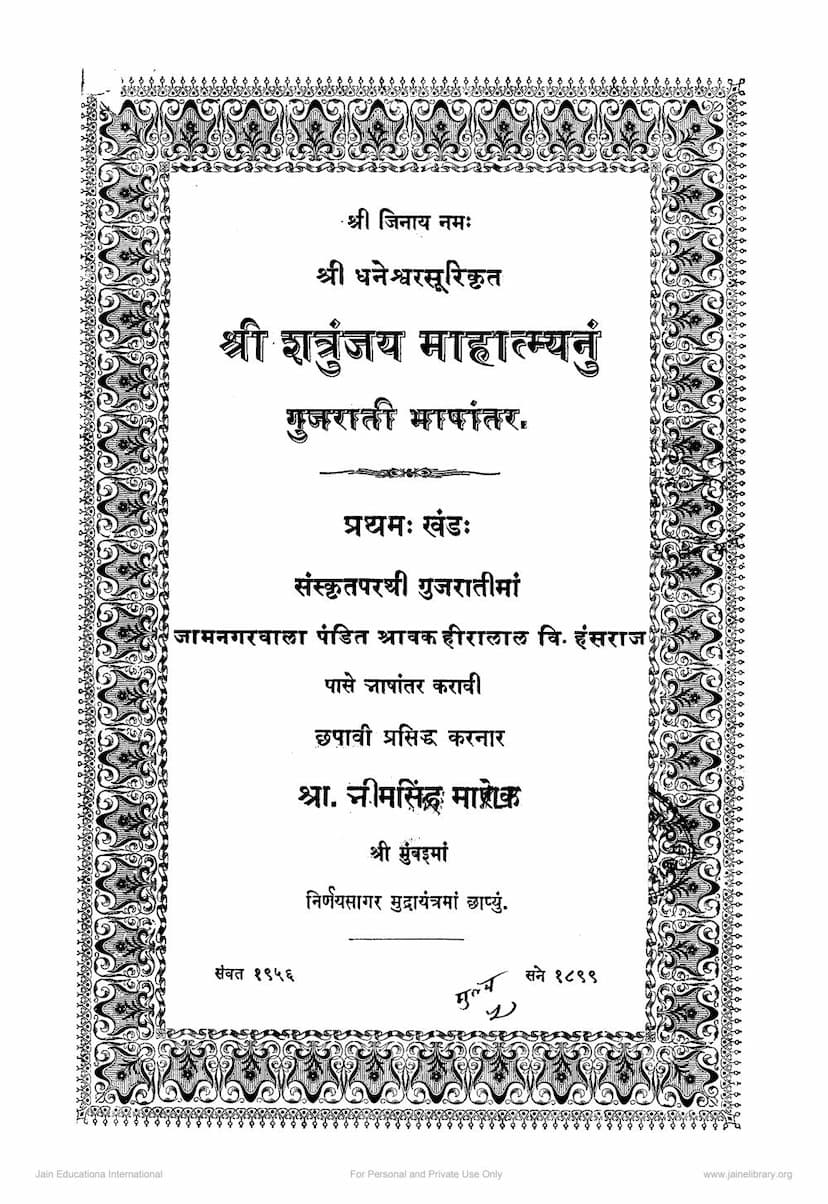Shatrunjaya Mahatmya
Added to library: September 2, 2025

Summary
Certainly! Here's a comprehensive summary of the Jain text "Shatrunjaya Mahatmya" by Shravak Bhimsinh Manek, based on the provided catalog link and text snippets:
Book Title: Shatrunjaya Mahatmya Author: Shravak Bhimsinh Manek (Publisher) Original Author (Sanskrit): Acharya Shri Dnyaneshwar Suri Original Work: A Mahakavya (epic poem) of 10,000 verses, based on earlier works of Pundarik Ganadhar (1.25 lakh verses) and Sudharmaswami (24,000 verses). Language: Gujarati translation of the Sanskrit original. Publisher: Shravak Bhimsinh Manek, printed at Nirnaysagar Press, Mumbai. Publication Year: Samvat 1956 (corresponding to 1899 CE). Catalog Link: https://jainqq.org/explore/005362/1
Comprehensive Summary of Shatrunjaya Mahatmya
The Shatrunjaya Mahatmya, as presented in this Gujarati translation, is a significant Jain text that elaborates on the glory and sanctity of the sacred pilgrimage site of Shatrunjaya. The book, published by Shravak Bhimsinh Manek in 1899 CE, is a translation of the Sanskrit work originally composed by the esteemed Acharya Shri Dnyaneshwar Suri.
Core Purpose and Significance:
The text emphasizes that in the current era (Pancham Kal), when Tirthankaras and Kevalis do not physically reside on Earth, the "Shri Shatrunjaya Mahatirtha" is the primary means for souls to cross the ocean of worldly existence and achieve liberation. The introduction highlights the immense spiritual benefit derived from reading, listening to, or even remembering Shatrunjaya, urging all Jain brethren to engage with the text.
Historical and Textual Lineage:
The Mahatmya's lineage is traced back through prominent Jain scholars:
- Pundarik Ganadhar: Composed a monumental work of 1.25 lakh verses during the time of Lord Rishabhdev.
- Sudharmaswami: A disciple of Lord Mahavir, abridged this into a 24,000-verse composition during Lord Mahavir's era.
- Acharya Shri Dnyaneshwar Suri: At the request of King Shiladitya of Vavanipur, created the 10,000-verse Sanskrit Mahakavya, noted for its ornate language and poetic embellishments. This is the original work translated into Gujarati.
Content Overview (Based on the detailed Table of Contents):
The book is structured into several "Sargas" (chapters), covering a wide range of topics related to the Shatrunjaya pilgrimage and Jain theology, history, and mythology:
Volume 1 (Pratham Khand):
- Introduction: Explains the significance of Shatrunjaya and the lineage of the text.
- Mangalacharan (Invocation): Recites praises to the Pancha Parmeshthis (Arhant, Siddha, Acharya, Upadhyaya, Sadhu) and various Tirthankaras like Lord Adinath, Lord Shantinath, Lord Neminath, and Lord Parshvanath.
- Praise of Shatrunjaya Mahatirtha: Details the immense glory and power of Shatrunjaya.
- Lord Mahavir's Visit to Shatrunjaya: Describes the sacred arrival of Lord Mahavir at the site.
- Descriptions of Shatrunjaya and surrounding areas: Provides detailed, ornate descriptions of the mountain and its environs, including its various peaks and the sacred Rayan tree.
- Kandu Raja's Narrative: Recounts the story of King Kandu, his spiritual journey, and the advice given to him by the Goddess Ambika and Munis regarding the glory of Shatrunjaya and the nature of true conduct.
- Lives of Tirthankaras and Devotees: The text includes numerous stories and biographies, such as those of King Mahipal, King Trivikram, Gunundari, Vidhyadhar, and others, illustrating the spiritual principles and the rewards of devotion.
- Praise of various Kundas (Tanks): Details the sanctity and benefits of bathing in sacred water bodies like Suryavarta Kunda.
- Devotional Stotras and Deshnas: Includes descriptions of Samavasarana (preaching assemblies) and the devotional hymns sung by deities like Saudharma.
The table of contents further breaks down the Sargas into specific topics and narratives, covering:
- Sarga 1 (Pratham Sarg): Focuses on the initial glorification of Shatrunjaya, including the story of King Kandu, the arrival of Lord Mahavir, and descriptions of the mountain's beauty and divinity.
- Sarga 2 (Dwitiya Sarg): Features narratives like King Mahipal's story, his encounters with yogis and yoginis, and his eventual liberation.
- Sarga 3 (Tritiya Sarg): Delves into the births and lives of Tirthankaras like Lord Rishabhdev, detailing his ascendance to kingship, his renunciation, and his attainment of Keval Gyan, along with the accounts of Bharat Chakravarti's conquests and eventual devotion.
- Sarga 4 (Chaturtha Sarg): Continues with the epic of Bharat Chakravarti, his conflict with his brother Bahubali, and their eventual spiritual paths.
- Sarga 5 (Panchama Sarg): Further elaborates on the sanctity of Shatrunjaya, including the glorification of its rivers and gardens, and potentially the continuation of Tirthankara narratives.
- Sarga 6 (Shashtha Sarg): Likely continues with more narratives and descriptions related to the Mahatirtha.
- Sarga 7 (Saptama Sarg): Might focus on specific legends or further expand on the spiritual significance.
- Sarga 8 (Ashtama Sarg): Begins with the lineage of Tirthankaras and kings, detailing the birth of Lord Ajitnath, the exploits of Sagar Chakravarti, and the stories of other righteous rulers.
- Sarga 9 (Navama Sarg): Likely covers the popular story of Lord Rama, Lord Ravana, and other figures, possibly weaving them into the larger narrative of Dharma and liberation.
Key Themes:
- The Supremacy of Shatrunjaya: The text consistently reinforces Shatrunjaya as the ultimate pilgrimage, offering immense spiritual merit.
- Devotion and Penance: The stories highlight how devotion, righteous conduct, penance, and pilgrimage lead to liberation.
- The Power of Austerity and Renunciation: The lives of kings and ascetics often illustrate the path to spiritual attainment through renunciation.
- Consequences of Karma: Numerous narratives serve as examples of how past actions (karma) influence present lives and future destinies.
- Jain Philosophy and Practice: The text implicitly and explicitly conveys core Jain principles like Ahimsa (non-violence), Satya (truthfulness), Asteya (non-stealing), Brahmacharya (celibacy/chastity), and Aparigraha (non-possession).
Overall:
The Shatrunjaya Mahatmya by Acharya Shri Dnyaneshwar Suri, as presented in this Gujarati translation, is a devotional and narrative work that serves as a spiritual guide and inspiration for Jains, particularly those who undertake or aspire to the pilgrimage of Shatrunjaya. It meticulously blends historical accounts, mythological stories, and theological teachings to elucidate the profound significance of this sacred site. The introduction and table of contents suggest a comprehensive exploration of Jain philosophy, Tirthankara stories, and the virtues that lead to Moksha (liberation).